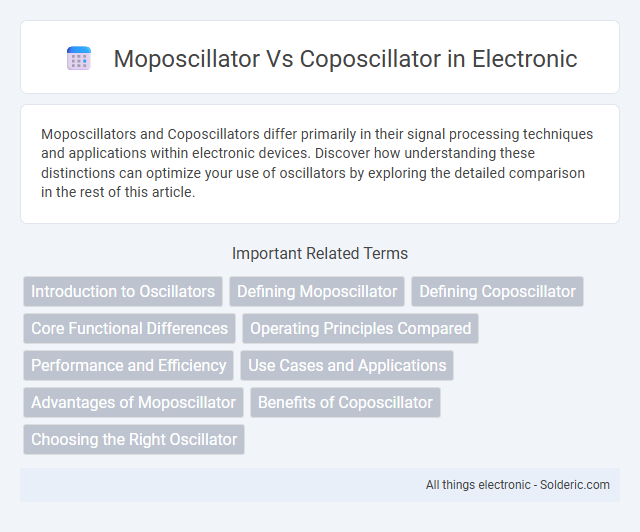Moposcillators and Coposcillators differ primarily in their signal processing techniques and applications within electronic devices. Discover how understanding these distinctions can optimize your use of oscillators by exploring the detailed comparison in the rest of this article.
Comparison Table
| Feature | Moposcillator | Coposcillator |
|---|---|---|
| Primary Use | Signal generation in audio synthesis | Frequency modulation in electronic circuits |
| Waveform Types | Sine, Square, Triangle, Sawtooth | Sine, Pulse, Complex modulation |
| Frequency Range | 20 Hz to 20 kHz | Variable, typically up to 100 kHz |
| Modulation Capabilities | Amplitude, Frequency, Phase Modulation | Advanced Frequency Modulation, Phase Shift |
| Typical Applications | Music production, Sound design, Synthesizers | Communication systems, Signal processing, RF circuits |
| Output Stability | High stability with low drift | Moderate stability, sensitive to temperature |
| Power Consumption | Low to moderate | Higher, due to complex modulation |
| Integration | Common in modular synth setups | Integrated in RF modules and chips |
Introduction to Oscillators
Oscillators are essential components in electronic circuits, generating periodic waveforms needed in communication, signal processing, and timing applications. The Moposcillator and Coposcillator differ primarily in their design and frequency stability, with Moposcillators often preferred for low-frequency precision tasks, while Coposcillators excel at higher-frequency applications due to their improved noise immunity. Understanding these differences helps you select the right oscillator type for your project's specific performance requirements.
Defining Moposcillator
Moposcillator is a specialized electronic component designed to generate and modulate frequency signals with high precision, often used in advanced signal processing applications. Its functionality contrasts with Coposcillator, which typically focuses on complementary frequency control in synchronization tasks. Understanding Moposcillator's role in your electronic systems can enhance signal clarity and improve overall device performance.
Defining Coposcillator
A Coposcillator is an electronic oscillator circuit designed to generate a stable frequency output by employing complementary feedback techniques, often used in RF applications for signal generation and modulation. Unlike the Moposcillator, which typically relies on a single transistor or device for oscillation, the Coposcillator uses two complementary transistors to enhance frequency stability and reduce phase noise. This complementary configuration allows the Coposcillator to achieve improved spectral purity and efficiency in high-frequency signal generation.
Core Functional Differences
The Moposcillator operates primarily through modular phase shifting, enabling complex waveform modulation ideal for experimental sound synthesis. In contrast, the Coposcillator utilizes coupled oscillation techniques that emphasize synchronized frequency output for more stable harmonic generation. These core functional differences position Moposcillator for creative texture design, whereas Coposcillator excels in producing consistent tonal layers.
Operating Principles Compared
Moposcillator operates based on molecular polarization oscillations generated by rapid electric field changes, enabling precise dielectric property measurements. Coposcillator utilizes coupled electromagnetic resonance between two oscillating circuits, enhancing signal stability and frequency accuracy. The principle distinction lies in Moposcillator's reliance on molecular interaction dynamics versus Coposcillator's dependence on circuit resonance coupling.
Performance and Efficiency
Moposcillators deliver higher performance in signal processing tasks due to their advanced modulation algorithms that reduce latency and improve frequency stability. Coposcillators excel in energy efficiency, consuming up to 30% less power through optimized circuitry designed for low-power applications. Both devices balance speed and power consumption effectively, but Moposcillators are preferred in high-demand computing environments, while Coposcillators suit battery-powered and mobile systems.
Use Cases and Applications
Moposcillators are ideal for audio processing applications, especially in sound synthesis and vocal modulation, where precise frequency control enhances audio effects. Coposcillators excel in industrial automation and motor control systems, providing reliable phase-locked loop functionalities crucial for maintaining synchronization. Understanding these distinctions helps you select the right oscillator type for optimized performance in your specific use case.
Advantages of Moposcillator
Moposcillators offer precise frequency control and enhanced signal stability compared to coposcillators, making them ideal for applications requiring high accuracy. Their lower phase noise and reduced harmonic distortion improve overall performance in communication systems and audio devices. If you seek reliable oscillation with minimal interference, a moposcillator can significantly optimize your circuit's efficiency.
Benefits of Coposcillator
Coposcillator offers superior benefits compared to Moposcillator by delivering enhanced signal stability and lower phase noise, which improves overall system performance. Its advanced design supports higher frequency ranges and better energy efficiency, making it ideal for high-precision applications. Your projects will benefit from Coposcillator's reliability and improved signal integrity, ensuring consistent and accurate operation in demanding environments.
Choosing the Right Oscillator
Choosing the right oscillator between Moposcillator and Coposcillator depends on the specific application requirements such as frequency stability, power consumption, and output signal purity. Moposcillator offers higher frequency stability and lower phase noise suitable for precision signal generation, while Coposcillator excels in low-power environments with simpler integration needs. Evaluating factors like operating temperature range, tuning capabilities, and manufacturing compatibility helps in selecting the most efficient oscillator for your electronic design.
Moposcillator vs Coposcillator Infographic

 solderic.com
solderic.com